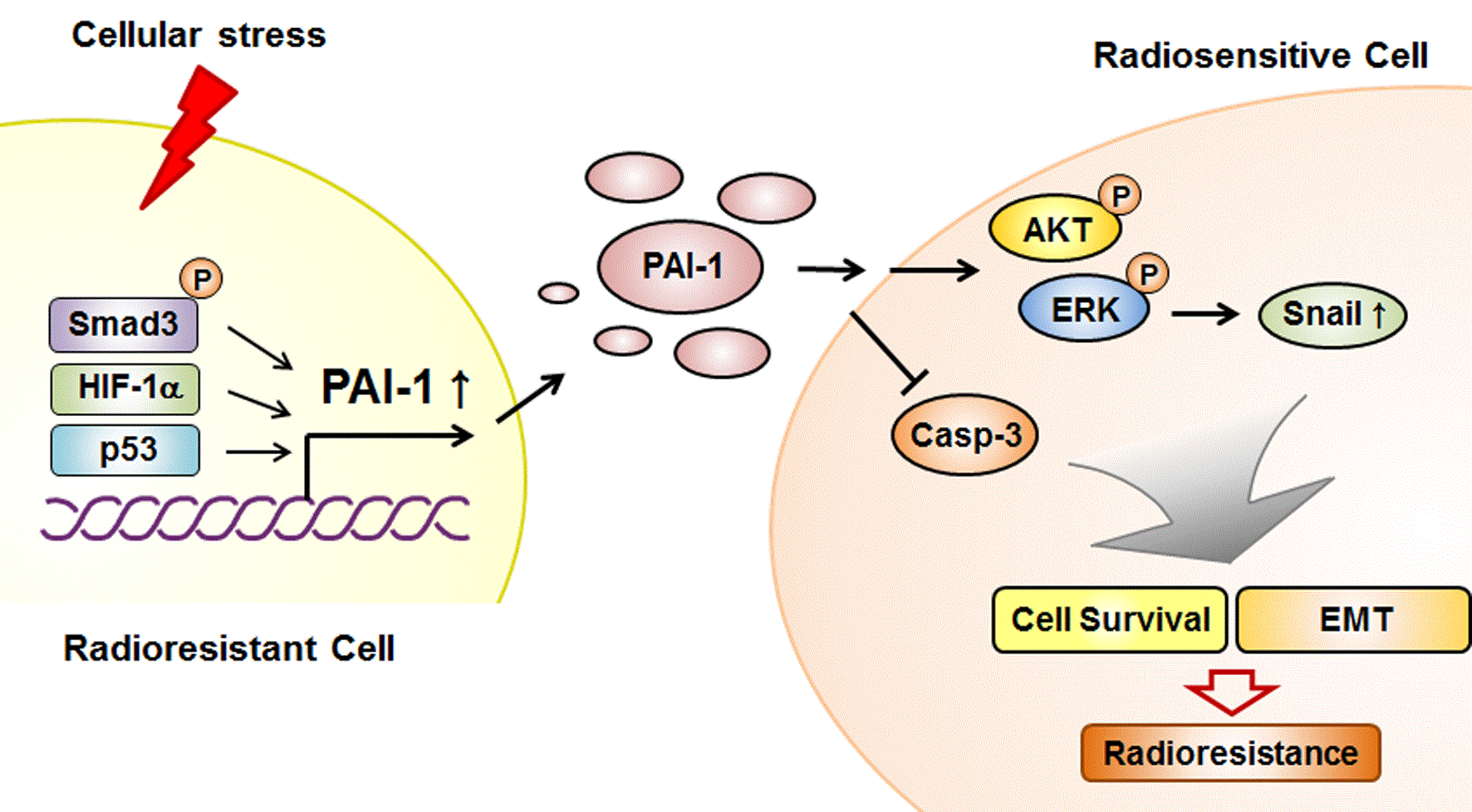글로벌 연구동향
방사선생물학
![[Oncotarget.] Plasminogen activator inhibitor-1 enhances radioresistance and aggressiveness of non-small cell lung cancer cells.](/enewspaper/upimages/admin_20160414095734_R.jpg) [Oncotarget.] Plasminogen activator inhibitor-1 enhances radioresistance and aggressiveness of non-small cell lung cancer cells.
[Oncotarget.] Plasminogen activator inhibitor-1 enhances radioresistance and aggressiveness of non-small cell lung cancer cells.부산대/ 윤부현*
- 출처
- Oncotarget.
- 등재일
- 2016 Mar 19
- 저널이슈번호
- doi: 10.18632/oncotarget.8208.
- 내용

AbstractAcquired resistance of tumor cells during treatment limits the clinical efficacy of radiotherapy. Recent studies to investigate acquired resistance under treatment have focused on intercellular communication because it promotes survival and aggressiveness of tumor cells, causing therapy failure and tumor relapse. Accordingly, a better understanding of the functional communication between subpopulations of cells within a tumor is essential to development of effective cancer treatment strategies. Here, we found that conditioned media (CM) from radioresistant non-small cell lung cancer (NSCLC) cells increased survival of radiosensitive cells. Comparative proteomics analysis revealed plasminogen activator inhibitor-1 (PAI-1) as a key molecule in the secretome that acts as an extracellular signaling trigger to strengthen resistance to radiation. Our results revealed that expression and secretion of PAI-1 in radioresistant cells was increased by radiation-induced transcription factors, including p53, HIF-1α, and Smad3. When CM from radioresistant cells was applied to radiosensitive cells, extracellular PAI-1 activated the AKT and ERK1/2 signaling pathway and inhibited caspase-3 activity. Our study also proposed that PAI-1 activates the signaling pathway in radiosensitive cells via extracellular interaction with its binding partners, not clathrin-mediated endocytosis. Furthermore, secreted PAI-1 increased cell migration capacity and expression of EMT markers in vitro and in vivo. Taken together, our findings demonstrate that PAI-1 secreted from radioresistant NSCLC cells reduced radiosensitivity of nearby cells in a paracrine manner, indicating that functional inhibition of PAI-1 signaling has therapeutic potential because it prevents sensitive cells from acquiring radioresistance.
Author information
Kang J1, Kim W2,3, Kwon T1, Youn H4, Kim JS5, Youn B1,2,3.
1Department of Integrated Biological Science, Pusan National University, Busan, 46241, Republic of Korea.
2Department of Biological Sciences, Pusan National University, Busan 46241, Republic of Korea.
3Nuclear Science Research Institute, Pusan National University, Busan 46241, Republic of Korea.
4Department of Integrative Bioscience and Biotechnology, Sejong University, Seoul 05006, Republic of Korea.
5Research Center, Dongnam Institute of Radiological and Medical Sciences, Busan 46033, Republic of Korea.
- 키워드
- EMT; NSCLC; PAI-1; paracrine; radioresistance
- 연구소개
- 세포의 paracrine 신호전달이 방사선저항성에 미치는 영향을 규명한 논문입니다. 방사선저항성 비소세포폐암 세포에 방사선이 조사되면 PAI-1의 발현이 증가하여 세포 밖으로 분비가 됩니다. 이렇게 분비된 PAI-1은 autocrine의 형태로 자가세포에 영향을 미치면서, paracrine 신호를 통해 인접한 방사선민감성 세포(PAI-1의 발현이 없는 세포)에도 영향을 미칠 수 있습니다. PAI-1은 방사선민감성 세포에 도달하여 AKT/ERK 신호를 활성화하고 Caspase-3 활성을 저해하여 세포 생존 및 전이능을 증가시켜 방사선저항성을 유도함을 확인하였습니다. 또한, PAI-1은 clathrin-매개성 세포내 섭취 작용을 통하는 것이 아니라 수용체와의 세포밖 상호작용을 통해 방사선민감성 세포에 방사선저항성 신호를 전달한다는 것을 밝혔습니다. 본 연구는 종양을 구성하는 다양한 세포들 중 PAI-1을 과발현하는 세포들이 자신을 포함한 주변 세포에 영향을 미쳐 전체적으로 방사선에 저항성을 나타내게 함을 규명한 것으로, 분비 단백질의 기능에 의한 세포간 상호작용이 방사선치료의 효율 저하를 유발할 수 있음에 대한 과학적 근거가 될 수 있습니다.
- 덧글달기









